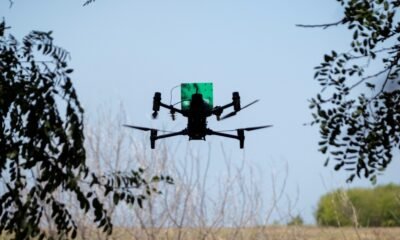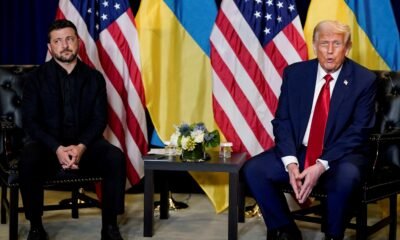INTERNACIONAL
Rusia avanza en la región ucraniana de Sumi y Kiev ordena más evacuaciones ante el temor a una gran una ofensiva

INTERNACIONAL
El cambio climático amenaza las ruinas de Cartago y otros sitios africanos

Las ruinas de Cartago, uno de los enclaves del mundo antiguo declarados Patrimonio de la Humanidad, enfrentan una amenaza diferente a las de su pasado militar: el avance del cambio climático. Los efectos de la crisis ambiental ya afectaron este sitio histórico de Túnez, donde la erosión costera, el incremento del nivel del mar y una salinidad creciente pusieron en peligro vestigios que resistieron más de 2.000 años.
En las Termas de Antonino, el mayor complejo termal romano de África, el desgaste es visible. Muchas columnas permanecen acordonadas para prevenir daños adicionales; los vientos salinos erosionan la piedra con intensidad. Cerca de allí, en el Puerto Púnico, fragmentos de la antigua isla portuaria se desprenden y caen al mar, reflejando la vulnerabilidad de estos monumentos frente al clima.
Lorenzo Nigro, director de la Misión Arqueológica de la Universidad La Sapienza de Roma en Cartago, advirtió: “El cambio climático es hoy una de las amenazas más graves y concretas para el patrimonio arqueológico, especialmente en las zonas costeras del Mediterráneo”.
Además, Nigro remarcó la necesidad de mantener vigilancia constante y emprender intervenciones oportunas para proteger los vestigios.

El escenario que afronta Cartago se replica a lo largo de la costa africana. Otros enclaves patrimoniales se ven expuestos a peligros similares. Un informe conjunto de la Unesco y el Instituto de Recursos Mundiales determinó que el setenta y tres por ciento de los sitios del Patrimonio Mundial sufrió amenazas hídricas, desde sequías hasta estrés por falta de agua o inundaciones costeras.
Un estudio publicado en la revista Nature Climate Change en 2022 examinó 284 sitios patrimoniales y naturales a lo largo de los 300.000 kilómetros de costa africana. El informe identificó que 56 de ellos, equivalentes al veinte por ciento, ya experimentaron riesgos de inundación y erosión costera.
Entre los lugares más amenazados destacan la isla Kunta Kinteh en Gambia, significativo enclave en la historia de la trata de esclavos, y el puerto comercial de Sabratha en Libia, célebre por su anfiteatro romano.

El aumento global de las temperaturas favoreció el derretimiento de los casquetes polares y la expansión térmica de los océanos, elevando así el nivel del mar. Este fenómeno aceleró la erosión costera y elevó la salinidad, lo que afectó la integridad de los materiales arqueológicos. La combinación de estos factores constituyó una amenaza inédita para el patrimonio cultural costero.
Las proyecciones científicas resultan poco optimistas. El estudio de Nature Climate Change calcula que, si las emisiones de gases de efecto invernadero continúan sin reducción, el número de sitios africanos en riesgo de erosión e inundación podría triplicarse para 2050, superando los ciento noventa enclaves afectados.
Nicholas Simpson, de la Iniciativa Africana sobre Clima y Desarrollo de la Universidad de Ciudad del Cabo, señala: “Nuestra respuesta al cambio climático es crucial para el patrimonio”. Asimismo, indica que lograr un recorte moderado de emisiones para 2050 podría reducir en un 25% la cantidad de sitios patrimoniales altamente expuestos.

Especialistas proponen una estrategia dual que combine la mitigación del cambio climático con acciones prácticas de adaptación en los propios sitios. Nigro sostiene que, además de reducir las emisiones de carbono, los gobiernos deben fortalecer la inversión en protección patrimonial.
Estas políticas incluyen fondos para investigación científica, monitoreo permanente, formación de personal local en tareas de conservación y planes de respuesta ante emergencias. Entre las acciones recomendadas para Cartago, se encuentran el enterramiento parcial de restos frágiles, la consolidación de estructuras y la instalación de refugios protectores.

La Unesco y otros organismos internacionales intensificaron sus esfuerzos, aunque especialistas insisten en que estas iniciativas requieren integración más efectiva con políticas de adaptación climática. El creciente volumen de investigaciones y advertencias busca movilizar a la comunidad internacional para evitar la pérdida irreversible de tesoros culturales.
La relevancia de estos enclaves va más allá de su historia: representan un recurso fundamental para el desarrollo sostenible, la educación y la identidad de las sociedades. La protección del patrimonio cultural frente al cambio climático demanda una respuesta colectiva global y sostenida.
INTERNACIONAL
Former Republican lawmaker looks to help US allies take power away from China

NEWYou can now listen to Fox News articles!
Cathy McMorris Rodgers is continuing her work on Middle East affairs after leaving Capitol Hill.
The former congresswoman recently spoke with Fox News Digital about her decision to join the U.S. Israel Education Association (USIEA) as a senior fellow to help cultivate the group’s leadership in the pharmaceutical space.
«I’m really excited to be helping advise the U.S. Israel Education Association, both as a former member of Congress, but also someone who is very supportive and believes that the U.S.-Israel relationship must be a priority,» Rodgers told Fox News Digital. «I’m advising them specifically on an initiative around friendshoring pharmaceutical supply chains into the Abraham Accord region.»
As co-founder of the Abraham Accords Caucus, Rodgers is familiar with the complex relationships the first Trump administration was able to form in the Middle East, bringing Israel and Arab nations closer together.
FORMER VICE PRESIDENT MIKE PENCE: FIVE YEARS ON, THE ABRAHAM ACCORDS STILL POINT THE WAY TO PEACE
Then-Rep. Cathy McMorris Rodgers, R-Wash., speaks during a House Subcommittee on Energy, Climate and Grid Security hearing in Washington, D.C., on Tuesday, Feb. 6, 2024. (Valerie Plesch/Bloomberg via Getty Images)
«I understand how vulnerable we have become because our pharmaceutical supply chain, so many of them are controlled by China. So, this initiative aligns with some of the priorities that I had while I was serving in Congress,» Rodgers added.
The Trump administration has made bringing manufacturing back to the U.S. a top priority. However, when domestic production is not possible, friendshoring could be the solution, relying on close relationships to get critical supplies.
When it comes to pharmaceuticals, China dominates the current market, particularly when it comes to the production of active pharmaceutical ingredients (APIs) and generic drugs, Rodgers said. In July, the Brookings Institution released a report in which it estimated that Chinese APIs were included in approximately one-quarter of drug volume sold in the U.S.
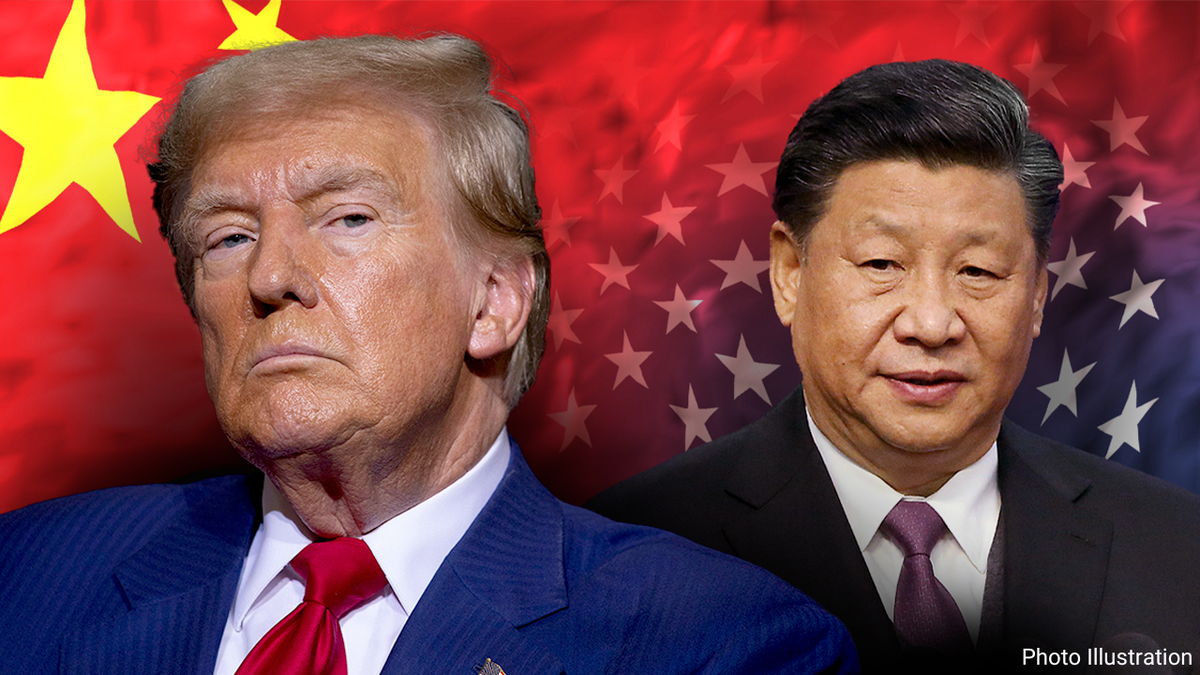
Donald Trump says 600,000 Chinese students could be allowed into the U.S. to study at its colleges pending a potential trade agreement with China. (Fox News)
OPINION: TRUMP’S LANDMARK DEAL IS THE REAL KEY TO PEACE IN THE MIDDLE EAST
«We see because of President Trump’s tariffs against China, many pharmaceutical companies are onshoring. So, they’re bringing back manufacturing to America. However, with the generics, which are 92% of the prescriptions in our nation, as well as the raw materials, the business reality is extremely difficult because of the cost of operation in the United States driven by regulations and labor costs. So, a region like the Abraham Accords, where Israel, UAE [United Arab Emirates], Bahrain and others, we could both source the raw material and these countries are investing a lot in research and in development and in manufacturing,» Rodgers said.
The former congresswoman emphasized the importance of the Abraham Accords and diplomatic initiatives started under President Donald Trump in 2020. She said that the initiative has succeeded in creating «government-to-government» ties, and now the USIEA is looking to expand on economic relationships between Abraham Accords nations.
Rodgers did not seem concerned about instability in the region impacting pharmaceutical supplies. She told Fox News Digital that other Abraham Accords Nations are interested in working with the U.S. on this initiative.
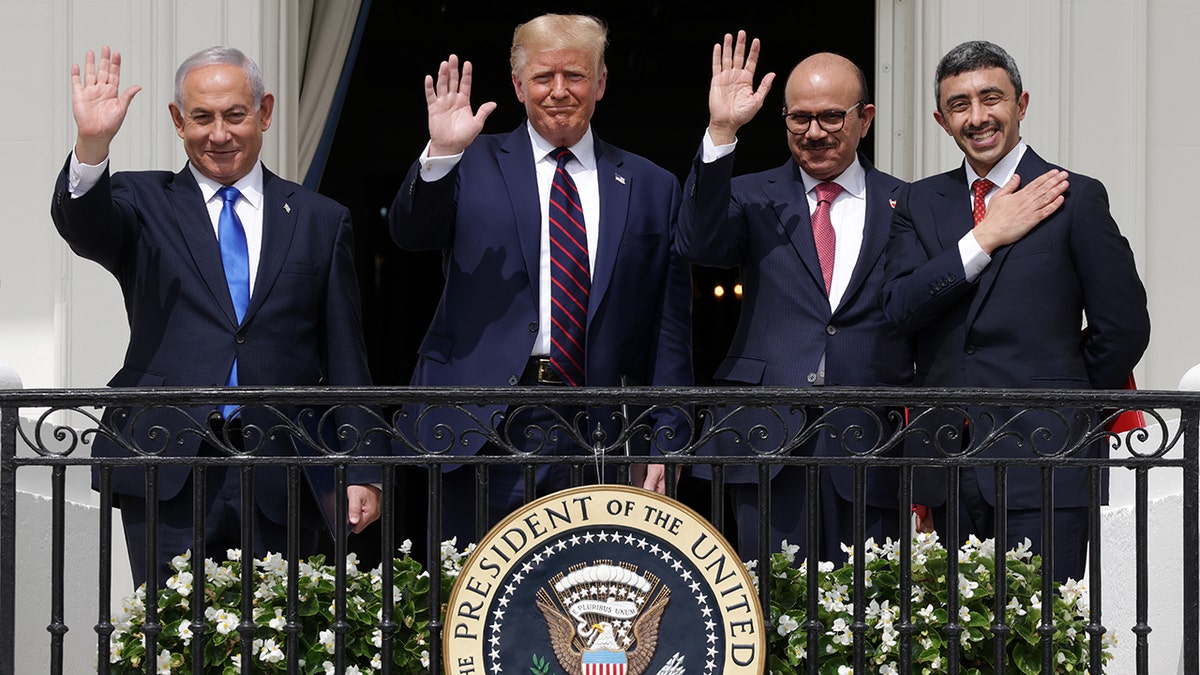
Israel Prime Minister Benjamin Netanyahu, President Donald Trump, Foreign Affairs Minister of Bahrain Abdullatif bin Rashid Al Zayani and Foreign Affairs Minister of the United Arab Emirates Abdullah bin Zayed bin Sultan Al Nahyan wave from the Truman Balcony of the White House on Sept. 15, 2020. (Alex Wong/Getty Images)
CLICK HERE TO GET THE FOX NEWS APP
«They want to diversify from what historically has been more energy, oil dominated,» Rodgers said. «It’s an idea whose time has come, I believe and it would. Serve both the purpose of ensuring our national security and preventing our dependence on foreign adversarial nations like China for these supply chains, but also building upon the Abraham Accords countries and the important relationship there.»
While she is no longer on Capitol Hill, Rodgers believes her former colleagues have a significant role to play in the initiative. She said that a top priority is getting an FDA office established in the region, something she hopes will get done this year.
middle east,israel,donald trump,china,medical research
INTERNACIONAL
Obama Presidential Center deposits just $1M into $470M reserve fund aimed to protect taxpayers

NEWYou can now listen to Fox News articles!
When the Obama Foundation snagged a sweetheart deal to build its beleaguered Obama Presidential Center on a Chicago public park, it pledged to create a $470 million reserve fund to spare taxpayers should the project ever go belly up.
But new tax filings show the foundation has only deposited $1 million into the fund and has not added to it in years, with critics saying the empty promise could potentially leave Chicagoans on the hook for hundreds of millions of dollars.
Under its agreement with the city, the foundation was required to create the fund, known as an endowment, in order to take control of the sprawling 19.3-acre section of Jackson Park — often described as Chicago’s Central Park equivalent — where the complex is now slowly rising.
The foundation ultimately secured the public land for just $10 in 2018, under a 99-year deal.
Former President Barack Obama is pictured next to construction of the Obama Presidential Center in Chicago, Illinois, a project facing delays, soaring costs and mounting scrutiny over its finances. (Scott Olson/Getty Images; REUTERS/Vincent Alban)
OBAMA LIBRARY, BEGUN WITH LOFTY DEI GOALS, NOW PLAGUED BY $40M RACIALLY CHARGED SUIT, BALLOONING COSTS
But when former President Barack Obama and former First Lady Michelle Obama turned the sod at the site in September 2021, just $1 million — or 0.21% of the pledged funds — had been deposited into the endowment, and that figure has remained unchanged ever since.
With construction progressing at a snail’s pace and costs ballooning from an original estimate of $330 million to at least $850 million, the lack of progress on the promised endowment has fueled fears the Obama Presidential Center could leave taxpayers holding the can if finances spiral into the red.
It comes as the Obama Foundation’s latest tax return shows its finances under strain with revenue swinging wildly year to year, fundraising shortfalls and unfulfilled donor pledges.
On news that the endowment has largely remained unfunded, Illinois GOP Chair Kathy Salvi slammed the project as an «abomination» while blasting Democrats for potentially exposing taxpayers with the deal.
«It should come as no surprise that the Obama Center is potentially leaving Illinois taxpayers high and dry — it’s an Illinois Democrat tradition,» Salvi told Fox News Digital in a statement. «Democrats in this state, when not going to prison for corruption, treat taxpayers like a personal piggy bank giving sweetheart deals to their political benefactors.»
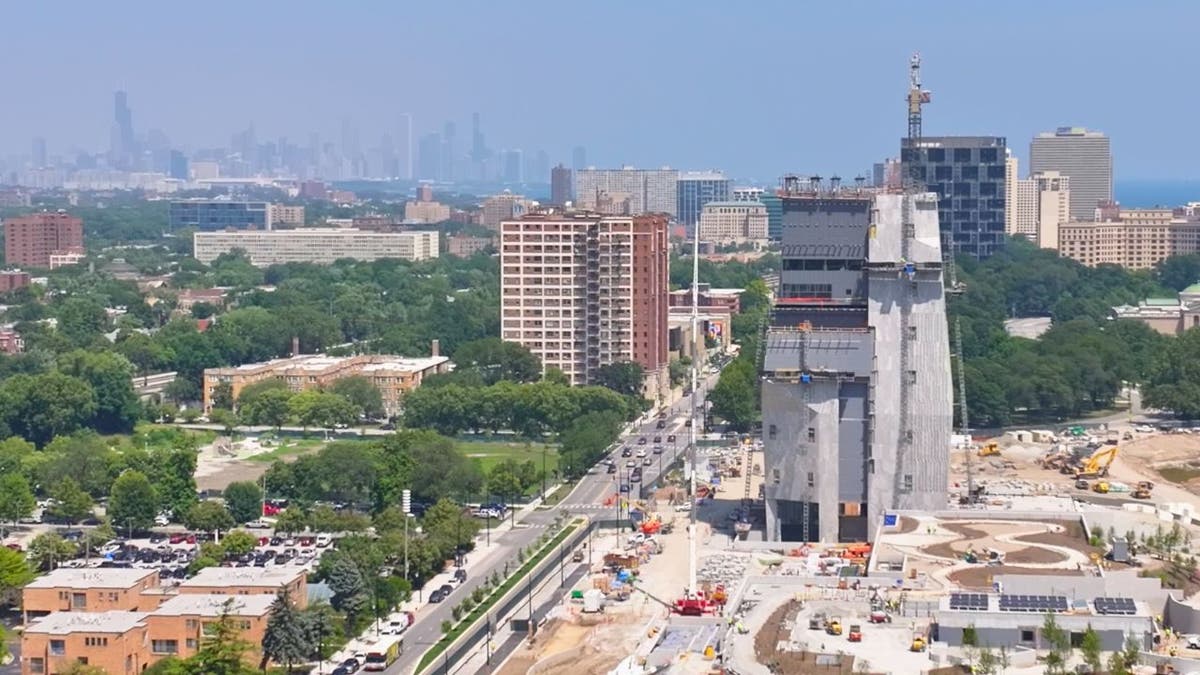
The Obama Presidential Center under construction in July. (Fox News Digital)
Scholar sounds alarm
Richard Epstein, a University of Chicago law professor emeritus and a New York University law professor, has raised concerns about the endowment for years and advised the local nonprofit Protect Our Parks with legal challenges to try to stop the Obama Center’s construction.
Epstein argues the foundation’s failure to fund its endowment confirms his long-held view that the city never should have signed over the large section of Jackson Park.
«They put a million dollars into a $400 million endowment, so it’s endowed. That gets you in jail as a securities matter,» Epstein told Fox News Digital. «An endowment means that you have the money in hand… But they have nothing. They just have the same $1 million that they put in in 2021 as far as I can tell. So I regard this as something of a public calamity.»
An endowment is a pot of money meant to earn enough interest each year to cover operating costs without touching the principle in order to avoid the taxpayer stepping in.
«Without an endowment, they’ll have to scramble every year to cover $30 million in operating costs,» Epstein said. «The whole point of an endowment is to avoid that volatility. They just haven’t endowed it. Of that I’m 100% sure.»
Epstein argues that if the foundation or center falters, the public could be saddled with traffic rerouting costs, environmental impacts, or even the bill for an incomplete building.
«Nobody knows exactly who is responsible for what if the project is abandoned or incomplete,» Epstein said. «There is a risk that the public will then have to bear that loss because the foundation won’t have the money.»
Epstein said the city has effectively looked the other way, declaring the foundation «compliant» on the endowment despite only $1 million ever being deposited. Proof, he argues, that officials never intended to enforce the requirement.
The Obama Foundation told Fox News Digital that it will be making «significant investments in the endowment in the coming years» as it has been prioritizing fundraising for the center and leadership programs.
«The Obama Presidential Center is fully funded and it will open in the spring of 2026,» a spokesperson for the foundation said.
CharityWatch, a nonprofit watchdog, told Fox News Digital that the foundation technically complied with its agreement by creating an endowment because the deal never set a dollar figure. The group also said that the foundation remains «well-funded» overall while also acknowledging the pledge risks, volatility and lack of a real endowment.
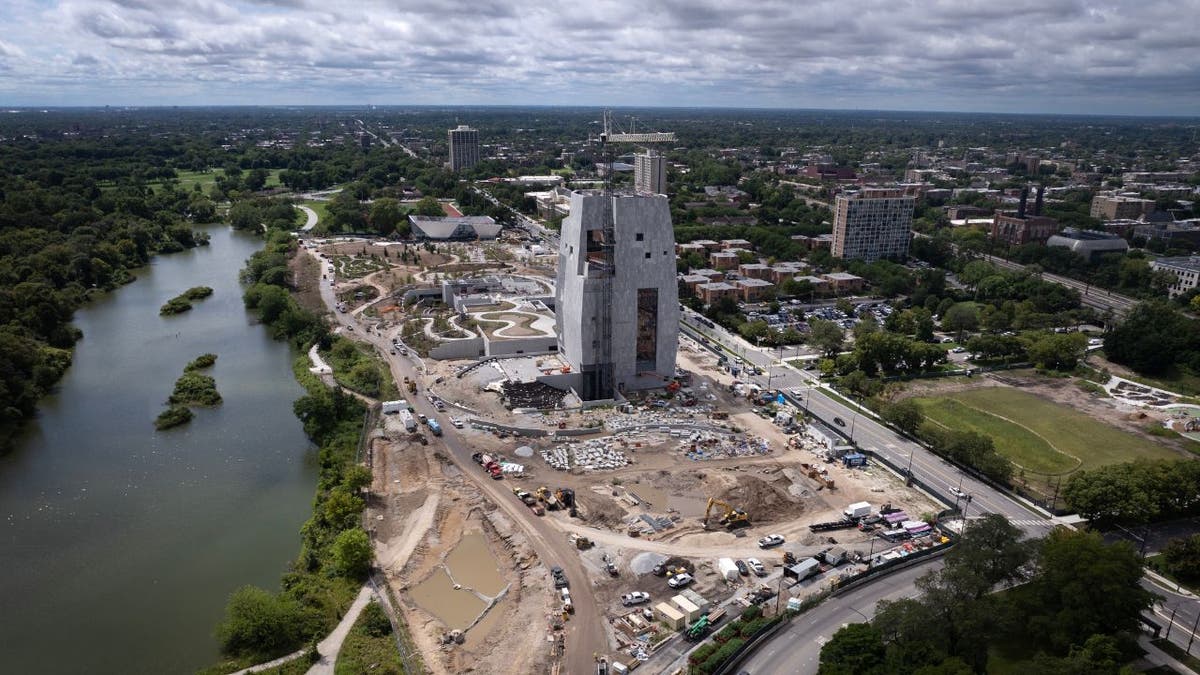
An aerial view shows construction of the Obama Presidential Center in Jackson Park, Chicago, Illinois, where costs have soared and questions remain about the project’s funding. (Scott Olson/Getty Images)
While the foundation’s agreement with the city required it to create an endowment, it did not specify an amount. The $470 million figure was being reported on as the city council deliberated on the deal and the foundation committed to that sum in its 2020 annual report.
In 2021 documents, the foundation said that first-year operating costs would be as much as $40 million. By that math, the center would actually need an endowment of between $800 million to $1 billion to fund operations without tapping the principle.
It’s also unclear how much revenue the foundation expects to generate each year.
Epstein said the lack of funds has long been the project’s Achilles heel. Without the endowment it promised, the project’s financial underpinning remains shaky, he said.
CHICAGO RESIDENTS CALL OBAMA PRESIDENTIAL CENTER A ‘MONSTROSITY,’ FEAR THEY’LL BE DISPLACED: REPORT
Despite financial pressures, the Obama Foundation has already spent about $600 million constructing the center, which aims to honor former President Barack Obama’s political career and be a civic hub. It consists of a 225-foot-tall museum, a digital library, conference facilities, a gymnasium and a regulation-sized NBA court. It will also house the Obama Foundation.
The new tax filings show the foundation ended 2024 with $116.5 million in cash, down nearly $80 million from the year before, while still owing about $234 million in construction costs. Of the funding gap, $216 million comes from firm pledges — promises of future donations — while another $201 million is tied up in conditional pledges that may never materialize if benchmarks aren’t met.
Epstein said the foundation’s financial assurances ring hollow, because a large chunk of the money it counts on is tied up in pledges and credit rather than cash in hand — leaving the center vulnerable to donor fatigue and year-to-year uncertainty.
WATCH: The Brian Kilmeade Show: Obama Presidential Center rocked by $40M racial bias lawsuit
Public trust doctrine
In the Protect Our Parks lawsuit, Epstein argued that handing Jackson Park to the Obama Foundation violated the public trust doctrine — which bars cities from giving away public land without a clear public benefit. The plaintiffs said the city gave away land worth nearly $200 million without securing enforceable returns for taxpayers.
However, U.S. District Judge John Robert Blakey, an Obama appointee, dismissed the case in 2019, ruling that the Obama Center qualified as a public use and that courts should defer to the city’s determination. The Seventh Circuit upheld the dismissal in 2020 and various other challenges by the plaintiffs have also failed on the public trust doctrine argument.
Epstein now points to the foundation’s failure to fund its promised endowment as proof the project never truly met the public benefit test and that a core part of his argument was valid.
As well as not being able to fill the endowment, the foundation is also financing a $250 million revolving credit line that it has yet to draw down but is costing the foundation hundreds of thousands of dollars in annual fees, according to the tax filings.
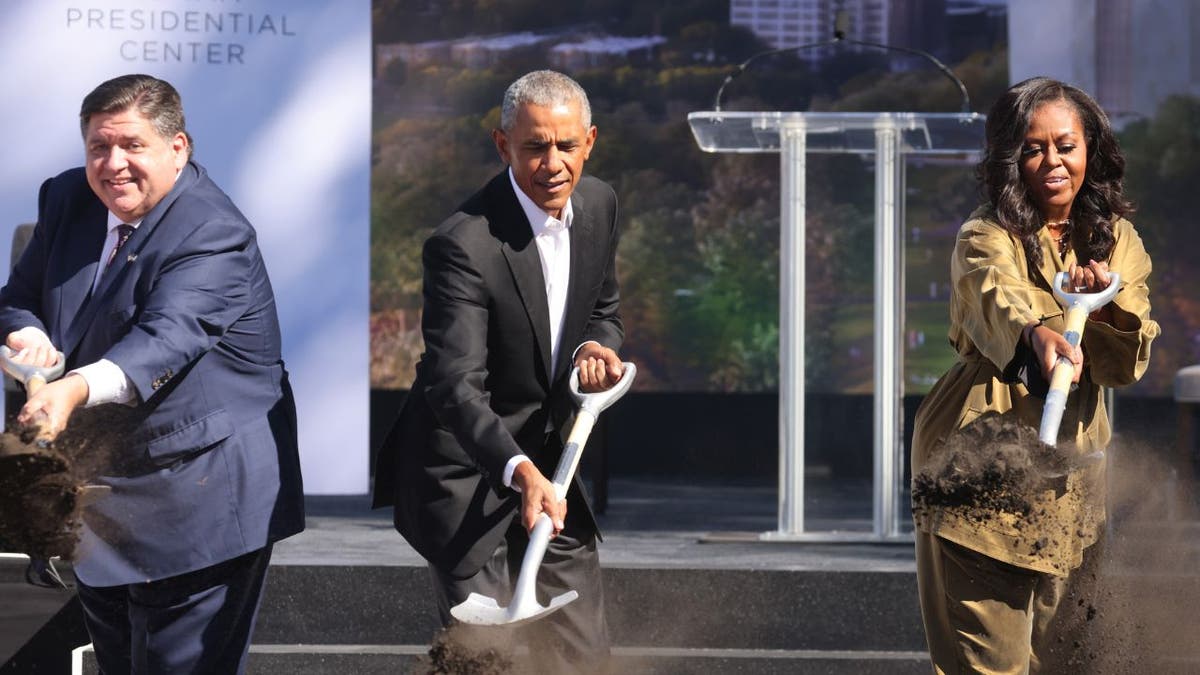
Illinois Governor J.B. Pritzker (L) joins former U.S. President Barack Obama and former first lady Michelle Obama in a ceremonial groundbreaking at the Obama Presidential Center in Jackson Park on Sept. 28, 2021 in Chicago, Illinois. At the time, around $1 million was in the endowment and it has remained relatively the same since. ( Scott Olson/Getty Images)
Easing oversight
Epstein argues the endowment shortfall is just one example of how the project has skirted safeguards.
Its 99-year deal with the city was rebranded as a «use agreement,» instead of a land lease, a legal pivot that he said let the city sidestep public-trust oversight and other regulatory checks.
The move grew out of an earlier fight over filmmaker George Lucas’s bid to build a Museum of Narrative Art on the lakefront. In 2016, a federal judge ruled the city’s plan to hand Lucas a 99-year lease of public parkland violated the public trust doctrine, sending Lucas packing for Los Angeles.
When the Obama Foundation arrived the following year, city officials adopted the new user agreement label. The terms were effectively the same — exclusive control for nearly a century in exchange for $10 — but by calling it a «use agreement,» the city claimed it no longer triggered the same scrutiny.
CLICK HERE TO GET THE FOX NEWS APP
Epstein called it a textbook case of bending the rules. «You can’t get out of a government regulatory relationship by changing the name on something,» he said.
Epstein said the foundation’s finances have never been fully scrutinized and his team was never allowed to examine the center’s internal records — from construction contracts to day-to-day statements — leaving the true state of its fundraising and shrouded in secrecy.
«They’ve gotten a free pass on both the environmental side and the financial side,» Epstein said. «Unless somebody cracks open the books, nobody really knows if they can actually fund this project. And if they can’t, it’s the public that will be left holding the bag.»
The offices of Mayor Brandon Johnson, Gov. J.B. Pritzker, the Democratic National Committee and the Democratic Party of Illinois did not respond to requests for comment.
barack obama,politics,chicago,democratic party,republicans,museums exhibits,education,presidential,michelle obama,law

 SOCIEDAD3 días ago
SOCIEDAD3 días agoQuiénes son los cuatro detenidos por el triple femicidio de Florencio Varela

 CHIMENTOS21 horas ago
CHIMENTOS21 horas agoMario Massaccesi confesó toda la verdad detrás de su fuerte pelea con Paula Bernini

 POLITICA2 días ago
POLITICA2 días agoPatricia Bullrich: “Kicillof tiene que hacerse cargo del problema enorme de inseguridad que tiene la provincia de Buenos Aires”


